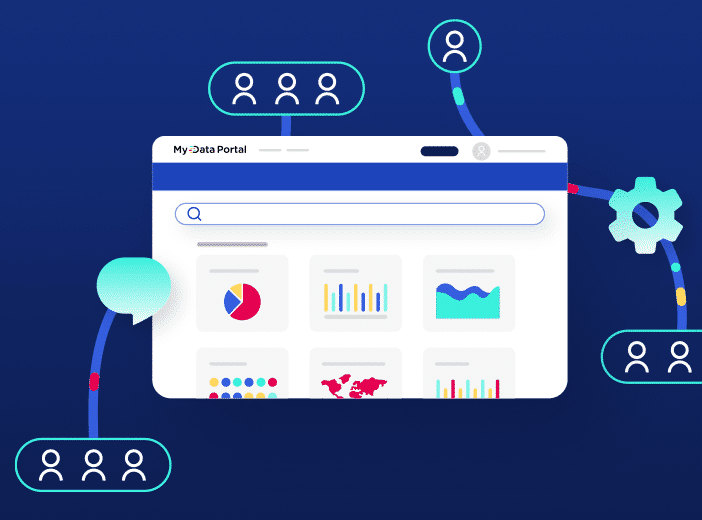Increasing data collection and driving collaboration through built-in forms
Data doesn’t just come from business systems and data producers - it can equally be provided by users and data consumers, widening the range of assets on your data marketplace. We explain how collecting data through integrated forms increases engagement, democratizes collection and strengthens your data community.

Creating a data-driven culture means educating and involving everyone with your data. Data product marketplaces provide a central space for self-service data sharing across the ecosystem, helping to increase collaboration, consumption and value. They can also widen the range of data available, collecting new types through built-in forms.
While often data assets are created by data producers within the business, it is vital to democratize creation, enabling all stakeholders and users to seamlessly contribute to the marketplace. One key way to achieve this is through data collection forms that allow data consumers to easily provide information that can then be added to the marketplace, visualized, and shared. This not only increases the richness and variety of available data assets but also drives greater engagement and ownership of the marketplace amongst stakeholders and enables the wider business to launch initiatives that collect and share data in a single place. Opendatasoft’s new forms feature underpins this collaboration and democratization, as we explain in this blog.
The need to democratize data collection
Many data products and assets are generated by business systems, Internet of Things (IoT) sensors or are provided by partners. However, the data ecosystem is potentially much richer than this, with organizations now looking to collect information directly from employees and stakeholders. These could be staff operating in the field, employees filling in surveys, or users updating lists of events or meetings.
Traditionally, this data was either collected through paper-based forms, or if it was digitized, through separate solutions that were not integrated directly with centralized, self-service data marketplaces. Adding it to the marketplace required additional steps, slowing down its availability and potentially leading to the formation of data silos.
To democratize data collection, users and employees need to be able to easily contribute information directly to the data marketplace so that it can be quickly visualized and shared. By incorporating digital forms directly into your data marketplace you not only widen the types and range of data that you collect, but also boost engagement and create a collaborative data community across your ecosystem.
Opendatasoft’s new forms feature enables the seamless collection of information while ensuring robust data governance in line with your corporate policies. Forms are created within the data marketplace back office, without requiring any technical skills or programming and then shared via links or QR codes. Users simply fill in the form on either their computer or mobile device, it is uploaded to the data marketplace, checked and then made available, both as raw data and as part of data visualizations such as graphs and dashboards. It can be added to existing datasets or used to create completely new ones.
Widening data collection through multiple use cases
Collecting data through forms has a wide range of uses, both inside and outside the organization. Examples include:
Digitizing data collection
Rather than collecting information on paper or via email and then manually digitizing it, using a form allows organizations to quickly and seamlessly request and receive information from stakeholders, such as employees. For example, an organization’s sustainability team could ask employees to provide information on green initiatives by completing a form, with this data then processed and visualized via the data marketplace. In the public sector, a municipality could create and publish a directory of local sports clubs, with information provided by the clubs themselves through forms.

Connecting with stakeholders
While there are multiple solutions that allow you to survey groups of stakeholders, none of these automatically integrates with your data marketplace, requiring additional time and resources to share data effectively with the entire organization. Launching surveys through the Opendatasoft forms feature enables organizations to quickly collect data, create new feedback loops and establish new workflows. For example, HR could launch an employee satisfaction survey through an Opendatasoft form, with the results being shared through a constantly updated dashboard on the data marketplace.

Creating and updating inventories
By providing forms to employees, especially those in the field, organizations can ensure that data on assets is constantly up-to-date. Employees can simply log equipment, including their condition and exact location using a form on their mobile device, with geolocated information and images automatically collected and used to update data asset inventories on the data marketplace. For example, telecoms engineers could mark and share the location of fiber equipment, sending photos to add to the dataset for greater detail. Making the process simple and seamless and using the capabilities of mobile devices encourages adoption and saves time for employees and the organization.
Key capabilities to enrich your data ecosystem
As with any technology that aims to increase data democratization, forms need to be seamless and user-friendly to encourage non-technical employees and stakeholders to fill them in – as well as easy for administrators and technical staff to create and integrate within their existing workflows. Therefore the Opendatasoft forms feature includes these capabilities:
Quick to create
Forms can be easily built, edited, customized and shared in just a few minutes, with a creation process that is based on a drag and drop interface similar to the existing Opendatasoft Studio. To further accelerate form creation, administrators can choose from a range of common field types (such as zip code or GPS location) or simply customize to meet their own requirements, as well as ensuring they are configured to match the structure of any existing datasets. Fields can be easily hidden or reactivated as required. Forms are designed to align with your marketplace’s branding and colors, and can be multilingual, switching to match the user’s specific language, providing a seamless and consistent user experience while avoiding form duplication.
Easy to share
Using the forms feature you can seamlessly choose who to share your form with, and how you share it. Pick recipients based on the groups already defined in your data marketplace workspace to match your security and access policies, or simply make the form accessible publicly without requiring additional registration. The Opendatasoft form feature lets you share the form in two ways – either through a URL that can be pasted into emails or displayed online, or through a QR code that makes it easy to access via mobile devices.
Seamless for users
In line with the overall data marketplace user experience, the process of completing the form is designed to be straightforward and intuitive. Specific fields can be pre-populated to save time, while end users can add their information with a single click, extracting data from their user profile or selecting a response from the records of an existing dataset. The Opendatasoft form harnesses the capabilities of mobile devices, such as integrating the camera to take and attach photos or images, and recording the exact geolocation where information has been added. All of this increases completion rates and speeds up publication.
Simple and secure publishing and sharing
A key benefit of the Opendatasoft forms feature is the amount of time that it saves. Data submitted by forms is automatically verified and added to datasets, avoiding the need for manual entry. However, it also features strong security and data governance capabilities to ensure businesses maintain complete control over the user experience. To maintain data quality, fields can be configured according to the type of data requested, with parameters added to avoid data entry errors. Moderation features control who can access and modify the form, based on your set governance rules.
To aid understanding and consumption, data collected through forms can be visualized in the same way as any other data asset on the Opendatasoft data marketplace. It can be displayed through intuitive, drill-down maps, real-time dashboards or as tables or graphics. Data can be downloaded in common file formats or shared through APIs to maximize reuse.
The benefits of integrating forms with your data marketplace
The Opendatasoft forms feature delivers multiple benefits to your data collection and consumption strategy:
- It widens your data ecosystem, allowing you to create a range of new data types from across your organization and external stakeholders
- It centralizes data in a single place (the data marketplace), making it available to all. This avoids the creation of data silos within specific survey tools or departments.
- It increases engagement around your marketplace. End users quickly become data contributors, boosting data democratization and growing overall participation in your data strategy.
All of this while making the whole forms process, from creation and completion to upload, seamless, intuitive and secure. Find out more about the Opendatasoft forms feature and its positive impact on data democratization by speaking to us now.



